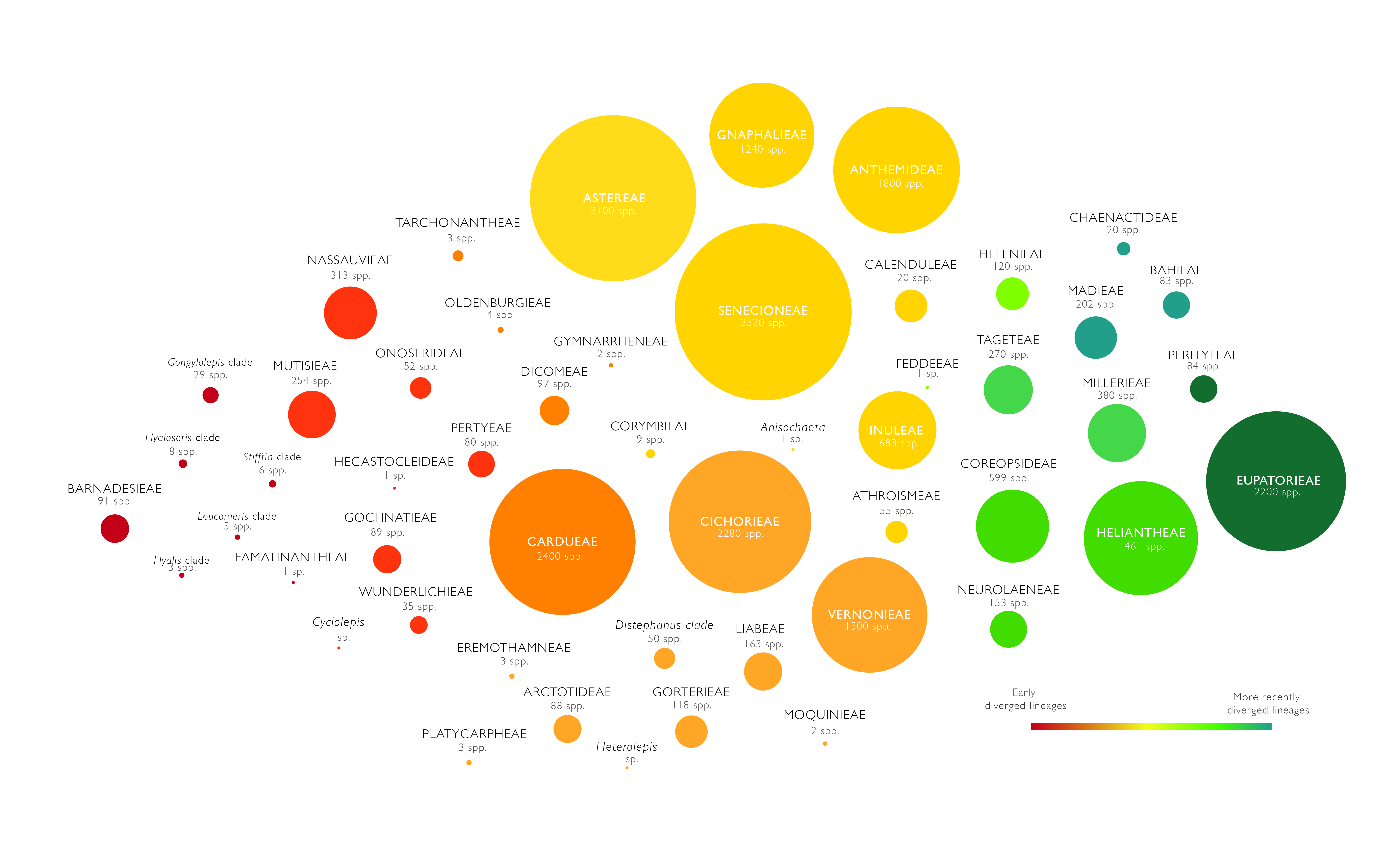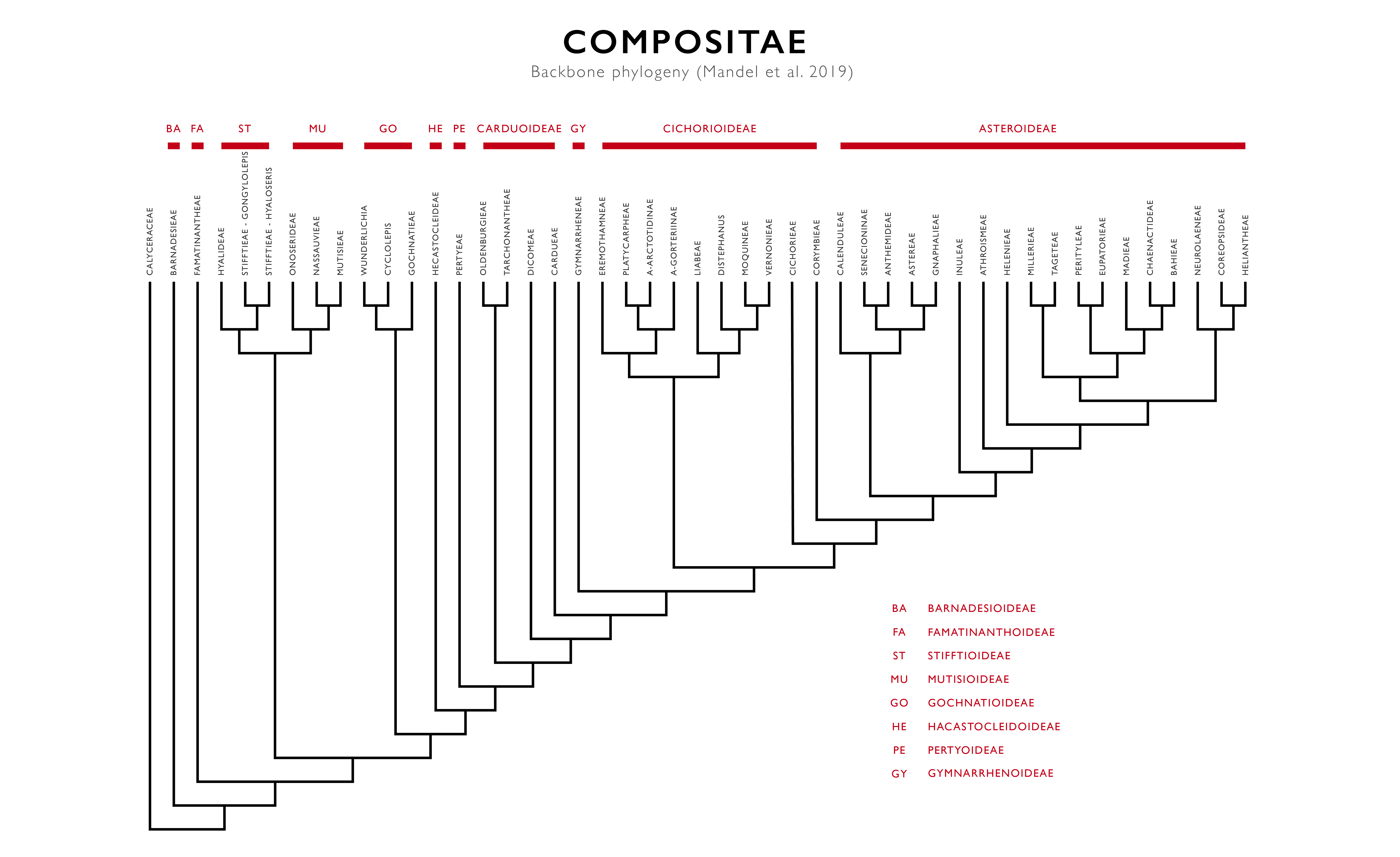
Bercht. & J.Presl, Prir. Rostlin 254 (1820), nom. cons.
Giseke, Prael. Ord. Nat. Pl. 538 (1792), nom. cons.
Compositae
Asteraceae
Modified from Funk et al. 2009.
Habit: annual herbs, also biennial or perennial herbs, subshrubs, shrubs, vines or trees, usually with one or more of various types of glandular and eglandular trichomes, commonly the glandular biseriate and the eglandular uniseriate; tissues usually with schizogenous secretory canals (resin-ducts) and/or with articulated lacticifers. Leaves: alternate or opposite, rarely whorled, usually simple but often lobed or divided, exstipulate. Inflorescence: a capitulum (head) surrounded by an involucre of one to several series of protective bracts (phyllaries), capitula sometimes solitary at the apices of more or less leafless stems (scapes) but usually few to many in second (sometimes third) order inflorescences (capitulescences, synflorescences) of various types, sometimes aggregated into often involucrate capituliform syncephalia. Receptacles: either naked or hairy and smooth, areolate with polygonal areoles or alveolate with depressions in which the florets are inserted, or paleate with persistent or caducous vascularized bracts (paleae, pales, chaff) subtending some or all of the florets, fimbrilliferous with non-vascularized fimbrils or scale-like processes surrounding the bases of the florets. Florets: small, 1–1000 or more per capitulum, sessile or subsessile. Calyx: a pappus associated with the fruit (see below). Corolla: gamopetalous, of (3–)5(–6) united petals, more or less regular (actinomorphic) and equally or unequally (3–)5(–6)-lobed or -toothed with the lobes or teeth valvate, or filiform with the lobes reduced or absent or with a minute ray, or variously zygomorphic, bilabiate with a 2-lobed internal (adaxial) lip and a 3-lobed external (abaxial) lip, pseudobilabiate with an unlobed internal (adaxial) lip and a 4-lobed external (abaxial) lip, ligulate with an apically 5-dentate abaxial ligule, or radiate with an abaxial 0–3(–4)-dentate ray, the different types variously arranged within the capitulum, the florets either all alike (homomorphic, isomorphic, capitulum homogamous) and all regular (capitulum discoid), all ligulate (ligulate capitulum) or all bilabiate, or of more than one type (heteromorphic, anisomorphic, capitulum heterogamous) with the inner (disc florets) regular (or rarely bilabiate) and perfect or functionally staminate and the outer (ray florets) radiate, often pistillate or sometimes sterile, in one or more series (capitulum radiate), or the outer filiform pistillate, usually in several series, and the inner regular, perfect or functionally staminate (capitulum disciform), rarely the corolla absent from the pistillate florets, occasionally all the florets pistillate or staminate and the plants dioecious or monoecious, rarely the florets variously otherwise arranged. Stamens: with the filaments inserted on the corolla-tube, equal in number to and alternating with the corolla lobes; filaments usually free, rarely connate, the upper part of the filament usually with thick-walled cells, forming a split cylindrical or balusterform anther-collar (or filament-collar); anthers united into a tube surrounding the style, very rarely free, dithecal, introrse, dehiscent by longitudinal slits, usually with an apical appendage, rounded, sagittate, calcarate or tailed at the base; tapetum integumentary; pollen mostly tricolporate, usually echinate (spiny), sometimes echinolophate or lophate (with a pattern of raised ridges) or spinulate (microechinate, spinulose), often caveate; nectary a thickened scale or cup surrounding the style base. Style: solitary, elongating through the anther-tube and extruding the pollen at its summit, apically divided (except sometimes in functionally staminate or apomictic florets) into two (rarely three) short to long branches (style arms) with stigmatic areas on their inner (adaxial) surfaces, the apices of the style arms acute to rounded, truncate or with various appendages; stigmas dry, papillose; ovary inferior, of two (rarely three) united carpels, unilocular, with one erect, basal ovule; ovule anatropous, tenuinucellate, unitegmic. Fruit: 1-seeded, indehiscent, usually an achene (cypsela), very rarely a drupe, crowned by a pappus formed of (1–)2 to many awns, scales (squamae, squamulae), setae or bristles in one or more series, homomorphic or heteromorphic, or by a more or less coroniform or auriculiform structure, or the pappus caducous or completely absent; abscission scar surrounded by a carpopodium, distinguished by the form of its cells and the texture of its surface, of one to many rows of cells, indistinct to prominent, sometimes apparently absent; embryo straight; endosperm scant, forming a thin layer around the embryo.
Funk, V.A., Susanna, A., Stuessy, T.F. & Bayer, R.J. 2009. Systematics, evolution, and biogeography of Compositae. Vienna: IAPT.
Anatomy of a capitulum

Heterogamous capitulum (radiate): a typical daisy
An heterogamous capitulum of the radiate type is the archetypical inflorescence of the Compositae. Almost all capitula consist of a somewhat flattened surface (a receptacle) that is surrounded by an involucre composed of a series of bracts (phyllaries). Florets usually lack a pedicel and are inserted in the receptacle.This particular type of capitulum has two types of florets, the marginal florets bearing zygomorphic corollas and the disk florets bearing actinomorphic corollas. There are many other types of capitula in the Compositae.
Taxonomic diversity
Taxonomic groups currently recognized in the family

Circle size is indicative of species diversity. Species numbers taken from Funk et al. (2009) and Anderberg et al. (2007). Species number for Cichorieae do not include apomictic species and microspecies.
The image above shows the latest published phylogeny by Mandel et al. (2019), which constitutes a highly supported backbone for the family based on a sample of 256 species and over 900 nuclear loci.
Mandel, J.R., Dikow, R.B., Siniscalchi, C.M., Thapa, R., Watson, L.E.& Funk, V.A. 2019. A fully resolved backbone phylogeny reveals numerous dispersals and explosive diversifications throughout the history of Asteraceae. Proc. Natl. Acad. Sci. U.S.A. 116 (28): 14083–14088. DOI

Contact: info@composite.org
